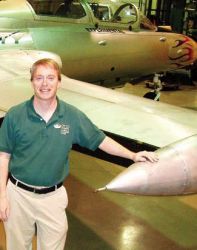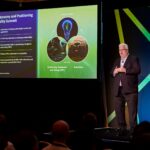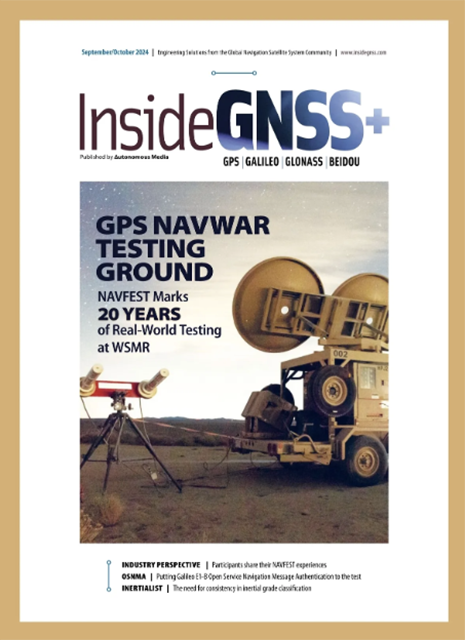
Much like the lead character in “Mr. Holland’s Opus,” a 1995 movie about another talented teacher, Mike Braasch found out that life happens while you’re busy making other plans. Braasch, now the Thomas Professor of Electrical Engineering at Ohio University’s Russ College of Engineering and technology, was unaware of how fast and hard he would fall for the three compass points of his subsequent life: Soo, the electrical engineering classmate who married him; the global navigation satellite system community; and his students.
Much like the lead character in “Mr. Holland’s Opus,” a 1995 movie about another talented teacher, Mike Braasch found out that life happens while you’re busy making other plans. Braasch, now the Thomas Professor of Electrical Engineering at Ohio University’s Russ College of Engineering and technology, was unaware of how fast and hard he would fall for the three compass points of his subsequent life: Soo, the electrical engineering classmate who married him; the global navigation satellite system community; and his students.
Braasch earned his M.E.E.E. and began working on GNSS in 1989 with his then-graduate advisor Frank van Graas, who had launched the GNSS research program with a few colleagues at the school’s Avionics Engineering Center in the early 1980s. “I was simply lucky enough to have picked the ‘right’ university to attend as an undergraduate and subsequently became involved in the program.”
His first task was to derive a computer model of GPS selective availability. That February, the first GPS satellite capable of implementing SA had been launched, and everyone was interested in how it behaved and how it would affect GPS accuracy.
“The real SA model was classified, so we had to derive our own models of this intentional signal degradation based on pseudorange and carrier-phase measurements,” Braasch says. His study was used by the satellite navigation community for SA simulation and proved to be the springboard for his career. Thankfully, he said, the results were not so alarmingly accurate as to attract a visit from “the men in dark suits and sunglasses.”
In 1992, Braasch completed his doctorate, also at Ohio University. His dissertation, “On the Characterization of Multipath Errors in Satellite-Based Precision Approach and Landing Systems,” won that year’s RTCA William E. Jackson Award for Outstanding Contribution to Aviation. Since then, Braasch has become an international expert in GPS multipath, antenna design, receiver processing and aviation applications.
In 1996, Braasch cofounded GPSoft LLC, which has produced MATLAB-based solutions for navigation simulation, analysis, and data processing. Braasch serves as technical director for GPSoft which Soo Braasch helps manage and market. The company’s SatNav Toolbox and Inertial Navigation System Toolbox have been put into use by industry, government, and academia in more than 14 countries. Last September the company expanded its MATLAB product line with release of the Navigation System Integration and Kalman Filtering Toolbox.
During the last two decades, Braasch has worked on a number of projects – including three of his favorites:
GNSS Software-Designed Receivers
Braasch is particularly proud that research into GNSS software-defined receivers began early at Ohio University. In 1994, Dennis M. Akos, one of Braasch’s graduate students, returned from a summer internship at NASA’s Glenn Research Center in Cleveland, Ohio. Akos had learned about the work being done on software-defined receivers in the communications field. Initially, Braasch encouraged Akos to use software to simulate the entire GPS receiver, from antenna to output data port. Before long, Akos started thinking about building a GNSS software-defined receiver and it became his dissertation topic.
“Back then, the processor speeds were insufficient to enable real-time operation, but we knew they would catch up eventually,” Braasch says. “A decade later, we have these receivers on the market and R&D is going on all over the globe.”
Multipath Characterization, Mitigation
For 15 years Braasch has led research efforts that have validated mathematical models both for pseudorange and carrier-phase multipath-induced error. In addition, he developed the initial concept for the integrated multipath-limiting antenna used to reduce ground reflections at DGNSS ground reference stations.
His former mentor, now colleague, van Graas and Michael F. DiBenedetto, a senior research engineer at the Avionics Engineering Center, took the initial concept and worked with dBSystems Inc. to continue development through to a production model.
Avionics Engineering at Ohio University
Ohio is one of the few universities in the world that can take an aircraft navigation project and carry it through flight testing. This is possible because the 43-year-old center owns several flight test aircraft and has the skilled personnel necessary to modify them for testing.
For most of its history, the center’s flight testing was conducted exclusively in propeller-driven aircraft. “By the late 1990s, I decided it was time for the center’s flight test capability to be expanded,” says Braasch, who holds an instrument flight–rated commercial pilot’s license. By 2000, he had secured the funding and approvals to purchase an L-29 Delfin, a former Eastern Bloc jet fighter trainer and the center’s first jet.
Over the past six years, he has led the team that transformed the aircraft into one capable of state-of-the-art flight testing, including a truth reference system based on high-end GNSS receivers and inertial navigation systems.
“The aircraft allows us to conduct high speed, high-altitude, and high-dynamic flight testing not possible in our other aircraft," Braasch says.
Meanwhile, Braasch and his team are developing an advanced cockpit display system, based on GNSS and low-cost inertial measurement units, to increase single pilot aircraft operations in poor visibility conditions.
And he has been teaching.
Frank van Graas is pleased at Braasch’s contributions to the GNSS community and how he has, in turn, become a mentor to others. “Locally, at Ohio University, Mike is best known for his contagious enthusiasm for and excellence at teaching.”
Just as van Graas encouraged Braasch to cut his engineering teeth on developing a computer model of SA, Braasch encouraged Dennis Akos to develop a GNSS software-defined receiver.
“It’s important to point out that the numerous students I have taught and advised over the years are by far my most important contribution to the GNSS community, “Braasch says. “Like most breakthroughs, our GNSS achievements stem from the close integrations of a number of players contributing to a greater cause.
Akos, his former graduate student, is now an assistant professor in Aerospace Engineering Sciences at the University of Colorado at Boulder. He says of his old mentor, “Professor Braasch is an outstanding educator, researcher and mentor in the field of satellite navigation. His knowledge of multipath — particularly the impact on GNSS receiver processing — is second to none.”
Braasch’s coordinates:
39° 12 36 N 82° 13 48 W
COMPASS POINTS
Engineering Specialties
GNSS antenna array design, GNSS software-defined receiver design, GNSS multipath characterization and mitigation
Engineering Mentor
Current colleague and former advisor Professor Frank van Graas “introduced me to the world of GNSS and was a fantastic source of encouragement.”
Favorite Equation
The carrier-phase multipath error equation
First Significant GNSS Achievement
A computer model of GPS Selective Availability (SA) in 1989. The real SA model was classified; so, Braasch and van Graas derived their own models of intentional signal degradation based on pseudorange and carrier-phase measurements. The result was used by the GNSS community for SA simulation.
His Compass Points
“I found my three families when I came to Ohio University — my wife Soo, also an electrical engineer; my talented team at the School of Electrical Engineering, and the GNSS community at large.”
Knew GNSS Had Arrived When . . .
References to GNSS first started appearing in Hollywood movies
Popular Notion about GNSS That Most Annoys
The idea, especially among non-commercial pilots, that the systems are perfect. “GNSS is a wonderful [technology], but guaranteeing its availability and integrity for safety-critical operations are non-trivial issues.”
Consumer Engineering Wish List
A smart radio in his car. “When I hear a song I like, I want to push a button and the radio would remember it. Over time, the radio would build a long list of songs — then it could scan all the channels in the background and look for ones playing songs I like.”
GNSS Secret
That novel manuscript with the GPS-driven storyline gathering dust on the shelf
What His Students Say about Him
“Always full of insight and innovation . . . with a vibrant personality.”
“His knowledge in the area of multipath, particularly the impact on GNSS receiver processing . . . is second to none.”
What’s Next?
Braasch and his team are developing an advanced cockpit display system, based on GNSS and low-cost inertial measurement units, to increase single pilot aircraft operations in poor visibility conditions.




